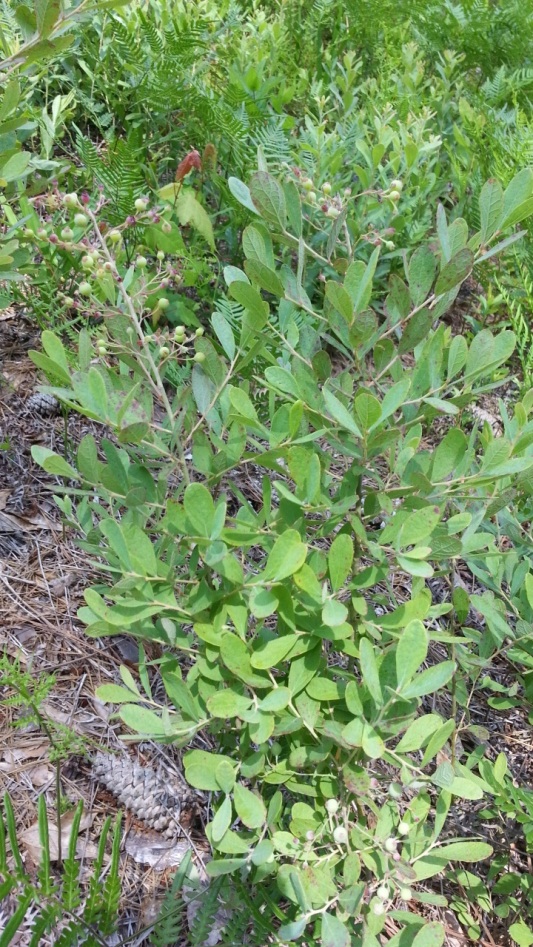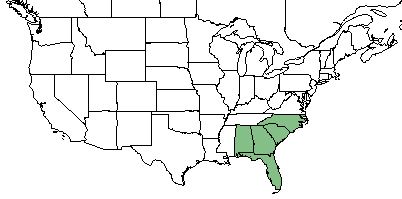Difference between revisions of "Gaylussacia tomentosa"
Krobertson (talk | contribs) (→Distribution) |
Krobertson (talk | contribs) |
||
| Line 38: | Line 38: | ||
===Fire ecology=== <!--Fire tolerance, fire dependence, adaptive fire responses--> | ===Fire ecology=== <!--Fire tolerance, fire dependence, adaptive fire responses--> | ||
| − | In Osceola National Forest, Florida, a burn frequency of 2 years yielded the greatest coverage of ''G. tomentosa'', although it remained present in the 1 and 4 year treatments as well.<ref>Glitzenstein J. S., Streng D. R., and Wade D. D. (2003). Fire frequency effects on longleaf pine (''Pinus palustris'' P. Miller) vegetation in South Carolina and northeast Florida, USA. Natural Areas Journal 23(1):22-37</ref> | + | In Osceola National Forest, Florida, a burn frequency of 2 years yielded the greatest coverage of ''G. tomentosa'', although it remained present in the 1 and 4 year fire interval treatments as well.<ref>Glitzenstein J. S., Streng D. R., and Wade D. D. (2003). Fire frequency effects on longleaf pine (''Pinus palustris'' P. Miller) vegetation in South Carolina and northeast Florida, USA. Natural Areas Journal 23(1):22-37</ref> |
<!--===Pollination===--> | <!--===Pollination===--> | ||
<!--===Use by animals===--> <!--Herbivory, granivory, insect hosting, etc.--> | <!--===Use by animals===--> <!--Herbivory, granivory, insect hosting, etc.--> | ||
Revision as of 16:21, 22 January 2018
| Gaylussacia tomentosa | |
|---|---|

| |
| Photo by the [ Atlas of Alabama Plants Database] | |
| Scientific classification | |
| Kingdom: | Plantae |
| Division: | Magnoliophyta - Flowering plants |
| Class: | Magnoliopsida - Dicots |
| Order: | Ericales |
| Family: | Ericaceae |
| Genus: | Gaylussacia |
| Species: | G. tomentosa |
| Binomial name | |
| Gaylussacia tomentosa (A. Gray) | |

| |
| Natural range of Gaylussacia tomentosa from USDA NRCS Plants Database. | |
Common Name(s): hairytwig huckleberry[1], hairy dangleberry[2]
Contents
Taxonomic Notes
Synonym(s): G. frondosa var. tomentosa;[1][2] Decachaena tomentosa[2]
Description
G. tomentosa is a dioecious perennial shrub.[1] It grows low and spreads locally via underground stems. Leaves are 2.5-7 cm (1-2.8 in) long, leathery, oblong or elliptic, and obtuse and apiculate at the apex. Pedicels are 1-1.5 cm (0.39-0.59 in) long and the calyx is glabrous and about 3.5 mm (0.14 in) wide. It is typically found in sandy soils.[3]
Distribution
Its primary distribution extends north from central peninsular Florida to central Georgia and southern South Carolina and westward to southwestern Alabama.[1][2] Occurrences have also been reported in a southern county of North Carolina and a northern county in Georgia.[1]
Ecology
Habitat
This species inhabits pine flatwoods, sandhills, and xeric coastal fringe sandhills.[2]
Phenology
G. tomentosa flowers from March through May.[2][4] Fruits mature afterwards from June through August[2][3]
Fire ecology
In Osceola National Forest, Florida, a burn frequency of 2 years yielded the greatest coverage of G. tomentosa, although it remained present in the 1 and 4 year fire interval treatments as well.[5]
Conservation and Management
Cultivation and restoration
Photo Gallery
References and notes
- ↑ 1.0 1.1 1.2 1.3 1.4 USDA, NRCS. (2016). The PLANTS Database (http://plants.usda.gov, 20 December 2017). National Plant Data Team, Greensboro, NC 27401-4901 USA.
- ↑ 2.0 2.1 2.2 2.3 2.4 2.5 2.6 Weakley A. S.(2015). Flora of the Southern and Mid-Atlantic States. Chapel Hill, NC: University of North Carolina Herbarium.
- ↑ 3.0 3.1 Small J. K. (1897). Shrubs and trees of the southern states. –II. Bulletin of the Torrey Botanical Club. 24(9):437-445.
- ↑ Nelson G. (20 December 2017) PanFlora. Retrieved from gilnelson.com/PanFlora/
- ↑ Glitzenstein J. S., Streng D. R., and Wade D. D. (2003). Fire frequency effects on longleaf pine (Pinus palustris P. Miller) vegetation in South Carolina and northeast Florida, USA. Natural Areas Journal 23(1):22-37